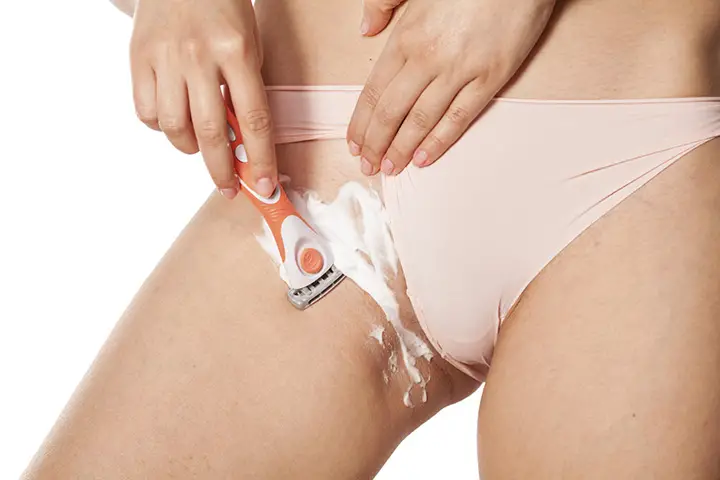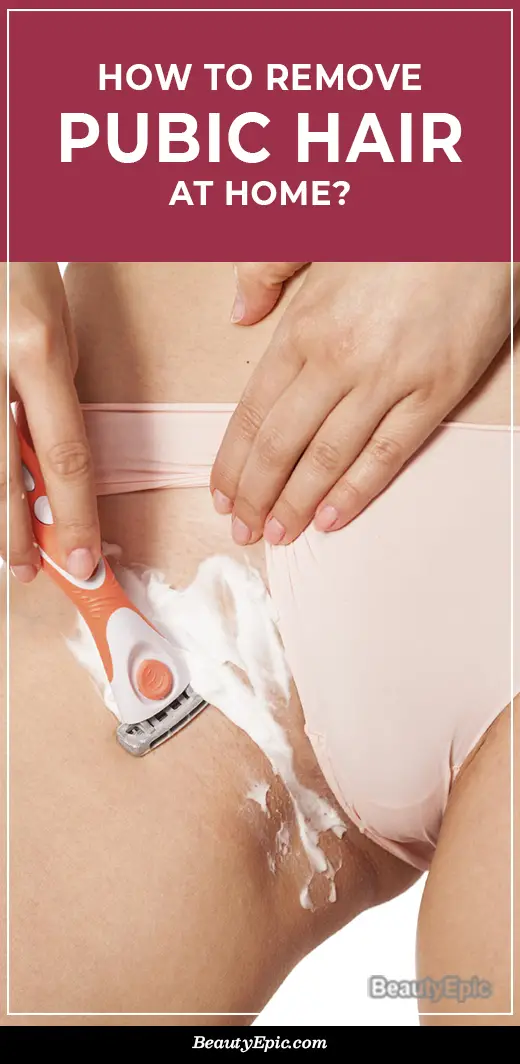
Important: This article is for informational purposes only. Please read our full disclaimer for more details.
Following the right method for removing pubic hair is essential to eliminate chances of irritation in the skin as the area has sensitive skin and coarse hair. There are various ways of doing this. We will look into each of the ways so that you can decide which is best for your skin type.
Article Contains
Ways of Removing Pubic Hair
1. Trimming
It is an important step before shaving to keep the razor blades sharp for longer. Scissors, bikini trimmers, or electric razors can be used for this. A mirror can be used while doing so to avoid chances of cuts and irritation.
2. Shaving

Skin in the pubic area is sensitive so you need to follow some steps to avoid skin irritation, ingrown hairs, or razor burns. These steps are as follows:
i. Exfoliating: Once the excess hair is trimmed, scrub the area using a loofah and a gentle scrub to remove the dead skin which is the primary reason for ingrown hair.
ii. Using a Sharp Razor: Make sure to use a razor that is clean and sharp because blunt ones lead to bums, irritation, and razor burns. Replace the razor if you feel like it is pulling off the hair from your skin or you are having a more itching sensation than usual.
iii. Hydrating and Washing: Before a warm shower or bath, make sure to soak the pubic area for at least 5 minutes. The skin has to be clean before shaving to ensure that the follicles are soft enough to remove the hair easily.
iv. Using Shaving Gel: This is essential for moisturizing while saving so that the blade glides across swiftly. Besides this, you don’t re-shave the same area by using the shaving gel and thus prevent chances of skin irritation.
v. Following the Hair Growth Direction: This must be done while shaving and the blade has to be washed after each stroke to ensure cleanliness. If you need a closer shave, apply the shaving gel again and cautiously shave against the hair growth direction.
vi. Moisturizing: Once hair is removed, pat the skin dry and use a mild alcohol-free moisturizer. Avoid tight clothing for at least an hour after shaving for better recovery.
[ Read: How to Get Rid of Ingrown Hairs on Legs ]
3. Tweezing
This takes time and is painful too but involves less risk. Try plucking a few hairs every day to spread out the pain as well as effort.
4. Using Hair Removal Cream
This is meant for those who are not particular about using natural hair removal methods. They dissolve the hair on the skin surface in the pubic area and make hair removal easier.
5. Waxing
This method prevents hair growth for a few weeks. The hot wax rips out the hair from its root. This opens the follicles and makes the skin prone to infection. Hence this is not the recommended method for those having sensitive skin.
Make sure that the wax that is being used is cleaned and not used by anyone else when you do it in a salon. It has some risks involved as the cleanest wax might also result in skin burn and folliculitis where red bumps appear on the skin.
[ Read: How to Use Baking Soda for Razor Bumps ]
6. Laser Hair Removal

In this treatment method, light energy is transformed to heat energy to damage the hair follicles under the skin so that the regrowth can be prevented. The process takes 2-6 months completed in 6-8 sessions. Since laster targets the dark pigment on the skin, it is suitable for people having dark hair on light skin. It may lead to skin irritation and pigmentation changes.
7. Electrolysis
It is a permanent hair removal method that is a good alternative to laser treatment but is quite tedious. In this method, heat or chemical energy is supplied to each hair follicle with fine needles inserted into them. The is a safe process but causes the skin to become red which gets back to normal after some time.
Final Words
When you are opting for hair removal at home, use the right tools and procedure and for permanent methods, opt for a clinic with a good track record for better outcomes. Practicing safety is the key to desired results upon completion of the hair removal process.
You Might Also Like:
- Do Redheads Have Red Pubes?
- Why Does My Leg Hair Grow So Fast?
- How to Use Apple Cider Vinegar for Razor Bumps
- How to Wax Your Legs at Home
- How to Use Aspirin for Razor Bumps
- 7 Best Oils For Hair Clippers
- 7 Best Numbing Creams For Laser Hair Removal
















